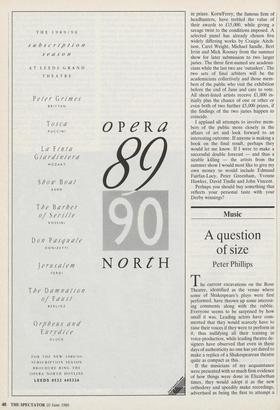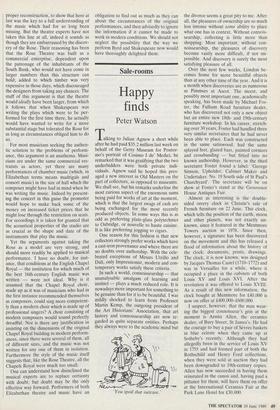Music
A question of size
Peter Phillips
The current excavations on the Rose Theatre, identified as the venue where some of Shakespeare's plays were first performed, have thrown up some interest- ing comments along with the rubble. Everyone seems to be surprised by how small it was. Leading actors have com- mented that they would scarcely have to raise their voices if they were to perform in it, thus nullifying all their training in voice-production, while leading theatre de- signers have observed that even in these days of authenticity no one has yet dared to make a replica of a Shakespearean theatre quite as compact as this. If the musicians of my acquaintance were presented with so much firm evidence of how things were done in Elizabethan times, they would adopt it as the new orthodoxy and speedily make recordings, advertised as being the first to attempt a proper reconstruction, to show that here at last was the key to a full understanding of the music which had for so long been missing. But the theatre experts have not taken this line at all, indeed it sounds as though they are embarrassed by the discov- ery of the Rose. Their reasoning has been that the Rose Theatre was built as a commercial enterprise, dependent upon the patronage of the inhabitants of the South Bank, who would not have come in larger numbers than this structure can hold; added to which timber was very expensive in those days, which discouraged the designers from taking any chances. The stuff of this argument is that the theatre would ideally have been larger, from which it follows that when Shakespeare was writing the plays which were to be per- formed for the first time there, he actually would have wanted to write for a more substantial stage but tolerated the Rose for as long as circumstances obliged him to do so.
For most musicians seeking the authen- tic solution to the problems of perform- ance, this argument is an anathema. Musi- cians are under the same commercial res- traints as actors, yet there are many performances of chamber music (which, in Elizabethan terms means madrigals and consort music) in the size of hall which the composer might have had in mind when he was writing the music. Indeed by present- ing the concert in this guise the promoter would hope to make back some of the money on increased ticket prices that he might lose through the restriction on seats. For recordings it is taken for granted that the acoustical properties of the studio are as crucial as the shape and date of the instruments that play the music.
Yet the arguments against taking the Rose as a model are very strong, and should more readily be applied to musical performance. I have no doubt, for inst- ance, that conditions at the English Chapel Royal — the institution for which much of the best 16th-century English music was written — were not ideal. Why is it assumed that the Chapel Royal choir, made up as it was of musicians who had in the first instance recommended themselves as composers, could sing more competent- ly than a modern choir which is made up of professional singers? A choir consisting of modern composers would sound perfectly dreadful. Nor is there any justification in insisting on the dimensions of the original Chapel Royal building in modern perform- ances, since there were several of them, all of different sizes, and the music was not written for any one of them in isolation. Furthermore the style of the music itself suggests that, like the Rose Theatre, all the Chapels Royal were much too small. One can understand how disinclined the musical experts are to replace certainty with doubt; but doubt may be the only effective way forward. Performers of both Elizabethan theatre and music have an obligation to find out as much as they can about the circumstances of the original performances, and then advisedly to ignore the information if it cannot be made to work in modern conditions. We should not neglect the possibility that the way we perform Byrd and Shakespeare now would have thoroughly delighted them.



























































 Previous page
Previous page